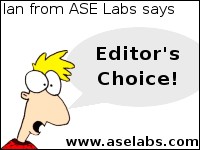Page 4: Testing, Conclusion
More Testing:
Moving on to the more intense demo3 from Nexuiz shows the true power of the 4870 start to shine through. The 3870 is being left in the dust. Even so, Nexuiz will still make graphics cards slow down on certain locations.
Moving on to ET:QW, this game was forced to 16xAF and 4xAA due to a problem with the game using 8xAA. I'm not sure what the problem was, but since Nexuiz worked fine at 8xAA, I'm assuming that the game was at fault. Even so, it shows the massive performance gain that the 4870 gives over its cousin.
2D performance is slightly worse than the 4850 probably due to the increased latency of the memory. I doubt you would ever notice this. Lower is better in this test.
Quality:
ATI has consistently had excellent quality 2D graphics and the trend continues. You will have no trouble even at high resolutions with this card. 3D quality is equally good. Using anisotropic filtering and anti-aliasing in games at high resolution is awesome. Having it being fluid is always a plus.
Conclusion:
The card costs about $285 at the time of this review and since this card is targeted to the enthusiast, it is a great price for the performance. Let's talk about where the card stands. The previous »4850 was a good mainstream card for performance and the price point was tough to beat. I still think the 4850 is the better price to performance winner, but that isn't the point of the 4870. We want raw performance.
The Sapphire Radeon HD 4870 delivers that raw performance and allows you to run at extremely high resolutions with full AA and AF settings. Gamers looking to buy a card should look no further. The Sapphire Radeon HD 4870 is as good as it gets for now. The X2 should be pretty impressive, but I doubt it will be even close to this price point (per performance). The 4870 is my choice for a performance video card.
I'd like to thank Don from Sapphire for making this review possible.
Moving on to the more intense demo3 from Nexuiz shows the true power of the 4870 start to shine through. The 3870 is being left in the dust. Even so, Nexuiz will still make graphics cards slow down on certain locations.
Moving on to ET:QW, this game was forced to 16xAF and 4xAA due to a problem with the game using 8xAA. I'm not sure what the problem was, but since Nexuiz worked fine at 8xAA, I'm assuming that the game was at fault. Even so, it shows the massive performance gain that the 4870 gives over its cousin.
2D performance is slightly worse than the 4850 probably due to the increased latency of the memory. I doubt you would ever notice this. Lower is better in this test.
Quality:
ATI has consistently had excellent quality 2D graphics and the trend continues. You will have no trouble even at high resolutions with this card. 3D quality is equally good. Using anisotropic filtering and anti-aliasing in games at high resolution is awesome. Having it being fluid is always a plus.
Conclusion:
The card costs about $285 at the time of this review and since this card is targeted to the enthusiast, it is a great price for the performance. Let's talk about where the card stands. The previous »4850 was a good mainstream card for performance and the price point was tough to beat. I still think the 4850 is the better price to performance winner, but that isn't the point of the 4870. We want raw performance.
The Sapphire Radeon HD 4870 delivers that raw performance and allows you to run at extremely high resolutions with full AA and AF settings. Gamers looking to buy a card should look no further. The Sapphire Radeon HD 4870 is as good as it gets for now. The X2 should be pretty impressive, but I doubt it will be even close to this price point (per performance). The 4870 is my choice for a performance video card.
I'd like to thank Don from Sapphire for making this review possible.





